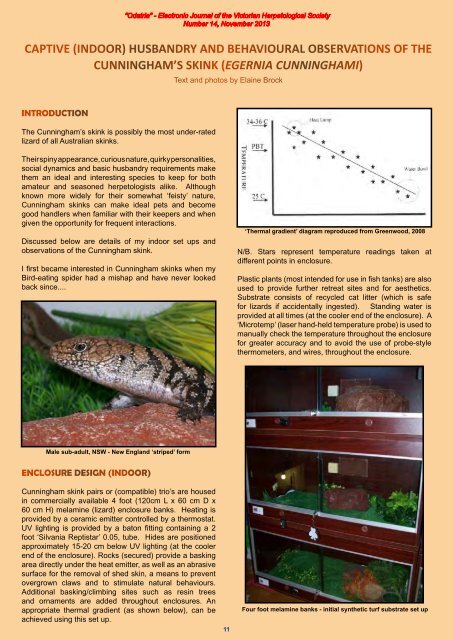Odatria_14_NOV13 - Victorian Herpetological Society
Odatria_14_NOV13 - Victorian Herpetological Society
Odatria_14_NOV13 - Victorian Herpetological Society
You also want an ePaper? Increase the reach of your titles
YUMPU automatically turns print PDFs into web optimized ePapers that Google loves.
CAPTIVE (INDOOR) HUSBANDRY AND BEHAVIOURAL OBSERVATIONS OF THECUNNINGHAM’S SKINK (EGERNIA CUNNINGHAMI)Text and photos by Elaine BrockINTRODUCTIONThe Cunningham’s skink is possibly the most under-ratedlizard of all Australian skinks.Their spiny appearance, curious nature, quirky personalities,social dynamics and basic husbandry requirements makethem an ideal and interesting species to keep for bothamateur and seasoned herpetologists alike. Althoughknown more widely for their somewhat ‘feisty’ nature,Cunningham skinks can make ideal pets and becomegood handlers when familiar with their keepers and whengiven the opportunity for frequent interactions.Discussed below are details of my indoor set ups andobservations of the Cunningham skink.I first became interested in Cunningham skinks when myBird-eating spider had a mishap and have never lookedback since....‘Thermal gradient’ diagram reproduced from Greenwood, 2008N/B. Stars represent temperature readings taken atdifferent points in enclosure.Plastic plants (most intended for use in fish tanks) are alsoused to provide further retreat sites and for aesthetics.Substrate consists of recycled cat litter (which is safefor lizards if accidentally ingested). Standing water isprovided at all times (at the cooler end of the enclosure). A‘Microtemp’ (laser hand-held temperature probe) is used tomanually check the temperature throughout the enclosurefor greater accuracy and to avoid the use of probe-stylethermometers, and wires, throughout the enclosure.Male sub-adult, NSW - New England ‘striped’ formENCLOSURE DESIGN (INDOOR)Cunningham skink pairs or (compatible) trio’s are housedin commercially available 4 foot (120cm L x 60 cm D x60 cm H) melamine (lizard) enclosure banks. Heating isprovided by a ceramic emitter controlled by a thermostat.UV lighting is provided by a baton fitting containing a 2foot ‘Silvania Reptistar’ 0.05, tube. Hides are positionedapproximately 15-20 cm below UV lighting (at the coolerend of the enclosure). Rocks (secured) provide a baskingarea directly under the heat emitter, as well as an abrasivesurface for the removal of shed skin, a means to preventovergrown claws and to stimulate natural behaviours.Additional basking/climbing sites such as resin treesand ornaments are added throughout enclosures. Anappropriate thermal gradient (as shown below), can beachieved using this set up.11Four foot melamine banks - initial synthetic turf substrate set up


